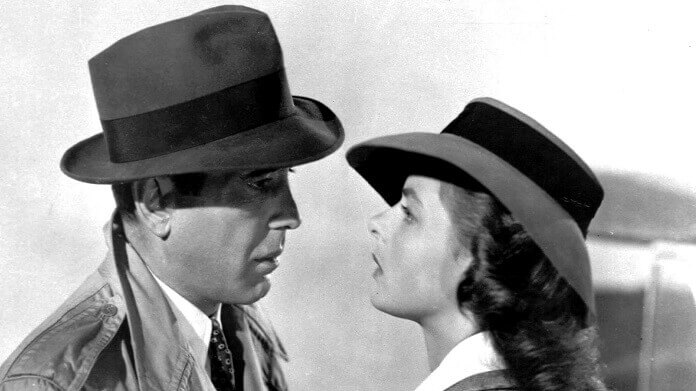
Does everybody come to Rick’s? Apparently so, in this classic Warner Bros World War II story of love, romance, desperation, gallantry, and double-crossing! Now celebrating its 75th anniversary, Casablanca has taken its place as one of the all-time greatest films ever made.
Based on the play Everybody Comes to Rick’s, a 1940 play written by playwright Murray Burnett and his co-writer Joan Alison, Warners assigned the screenwriting twin brothers Julius and Philip G. Epstein, and Howard Koch, to pen the shooting script. Also brought in to contribute to the screenplay was Casey Robinson. He would not take screen credit for his writing because he vowed never to acknowledge anything he didn’t write as sole screenwriter. This cost him an Oscar® when the statues were handed out.
Robinson was famous for writing a string of Bette Davis hits (Dark Victory, Now, Voyager, All This, and Heaven Too, The Old Maid, The Corn is Green), another Bogart hit (Passage to Marseilles), an Errol Flynn swashbuckler (Captain Blood), and a Ronald Reagan tearjerker (King’s Row), all at Warner Bros. He later left the studio for MGM and then 20th Century Fox.
The handsome Utah native (1903-1979) was married to premiere ballet dancer Tamara Toumanova. Ms. Toumanova made a name for herself in films by starring in several musicals (Invitation to the Dance with Gene Kelly at MGM, Tonight We Sing, Deep in My Heart, Torn Curtain, Billy Wilder’s The Private Life of Sherlock Holmes). Toumanova made her screen debut as Gregory Peck’s beautiful leading lady in Days of Glory in 1944. She was married to Casey Robinson from 1944 to 1955.
Humphrey Bogart was one of Warner Bros. biggest stars after appearing in several hits for the studio, such as The Petrified Forest (1936), Dark Victory (1939) with the bug-eyed Bette Davis, and The Maltese Falcon (1941). He was the only person who was right to play Rick. Jack Warner had originally had in mind future President Ronald Reagan to play Rick and Ann Sheridan to play the Ingrid Bergman part of Ilsa. Bad casting, one could say? Fortunately for the world, that casting fell by the wayside, and movie fans got the stars they wanted and loved.
On screen, Bogart and Bergman were equally matched. But as is always the case in Hollywood, nothing is what it seems. At only 5’-8” tall, Bogart was no match vertically with the gargantuan Bergman. The studio carpenters built elevated wooden blocks that could be attached to Bogart’s shoes to make him seem taller than Ms. Bergman in their clinches together! Sometimes they had to dig trenches for Bergman to walk in while Bogie towered over her above the trench. These scenes were shot from the waist up, of course, so that the Frankenstein soles on Bogie’s shoes did not show. A little lift never hurts.
Director Michael Curtiz, born in Hungary, cast the many parts of the film with refugees who fled Europe and the Nazis. A casual observation of the film’s actors will prove this. One part he did not cast with a refugee was the part Joy Page played (Annina Brandel, the young bride who may have to sleep with the corrupt Capt. Renault – Claude Rains – to get exit papers for her and her husband, played by Helmut Dantine.)
Ms. Page was the daughter of Ann Boyar who married studio mogul Jack Warner after she divorced her first husband, Joy’s father. Thus, Page was the stepdaughter of the infamous Jack L. Warner, the man who also signed her paycheck. Warner proved there was no nepotism involving his stepdaughter because he refused to sign her to a long-term contract or cast her in any further Warner Bros. films. She got back at her meanie stepdad by marrying William T. Orr, the man who ran Warner Bros television projects! Page died at 83 in 2008.
For me, the greatest actor in the film is Claude Rains who has the very best lines as the scoundrel Captain Renault. He holds the key to getting from Casablanca to Lisbon and subsequent freedom for those who are desperate to get the necessary papers for passage. Rains, born in Clapham, London, November 10, 1889 was a natural to appear on the stage because his father was an actor.
Rains made his debut at age 11. Rains was in New York in 1927 doing plays on Broadway when he was signed to a Universal Pictures contract for his first picture, The Invisible Man, in which he was a sensation using only his voice. By 1936 he moved across the San Fernando Valley to the Warner Bros. studio where he played a variety of roles, always stealing the picture from the star. One star he did not steal away scenes from was the formidable Queen of the Warner Bros. lot, fireball Bette Davis. They made four hit pictures together, Juarez (1939), Now, Voyager (1942), Mr. Skeffington (1944), and Deception (1946). But Rains is best remembered for his larcenous police Captain who is “Shocked! Shocked, to find gambling here!’ in Rick’s Casino as he picks up his winnings.
And yes, there are stellar performances by nearly every actor in the film. Paul Henreid was the third star of the film, playing Ilsa’s elegant freedom-fighting husband. Who can forget the slimy Ugarte, played by Peter Lorre (Fritz Lang’s 1931 horror film, M) who fled the real Nazis to become a star in the United States. The loveable S.Z. Sakall played Carl the waiter. He, too, had fled Europe only to become one of the most memorable and cuddly stars in many movies.
The despicable Major Strasser was played by former German film star Conrad Veidt. Ironically, he fled the Nazis only to end up playing Nazis in most of his American movies. And Sam, yes Sam, how can we not give him a special place in the annals of memorable characters? Without Dooley Wilson as Sam playing and singing the classic song “As Time Goes By” on the piano, Casablanca probably would not have become the classic it has been for 75 years.
Genre: Romance/ World War II Drama/ Adventure
Studio: Warner Bros.
Producers: Jack L. Warner, Hal B. Wallis
MPAA Rating: PG for mild violence
Our Rating: A
Running Time: 104 minutes
Format: Black and White
Budget: $950,000
Filming Dates: May 25, 1942 thru August 3, 1942
Crew:
Art Direction: Carl Jules Weyl
Assistant Director: Lee Katz
Cinematography: Arthur Edeson
Costumes: Orry-Kelly
Editing: Owen Marks
Makeup: Perc Westmore
Music: Max Steiner
Production Management: Al Alleborn
Set Decoration: George James Hopkins
Set Designer: Harper Goff
Sound: Francis J. Scheid, Edward Ullman (recordist)
Writing Credits: Julius & Philip G. Epstein (twins), Howard Koch, screenplay; Casey Robinson, uncredited screenplay; Murray Burnett, Joan Alison, original play
Director: Michael Curtiz
Cast:
Humphrey Bogart: Rick Blaine
Ingrid Bergman: Ilsa Lund
Paul Henreid: Victor Laszlo
Claude Rains: Captain Louis Renault
Conrad Veidt: Major Heinrich Strasser
Sydney Greenstreet: Signor Ferrari
Peter Lorre: Ugarte
S.Z. Sakall: Carl
Madeleine Lebeau: Yvonne
Dooley Wilson: Sam
Joy Page: Annina Brandel
Helmut Dantine: Jean Brandel
John Qualen: Berger
Leonid Kinsky: Sascha
Curt Bois: Pickpocket
Norma Varden: Wife of Pickpocketed Englishman
Marcel Dalio: Croupier
Dan Seymour: Abdul
Monte Blue: An American
Trude Berliner: Baccarat player






